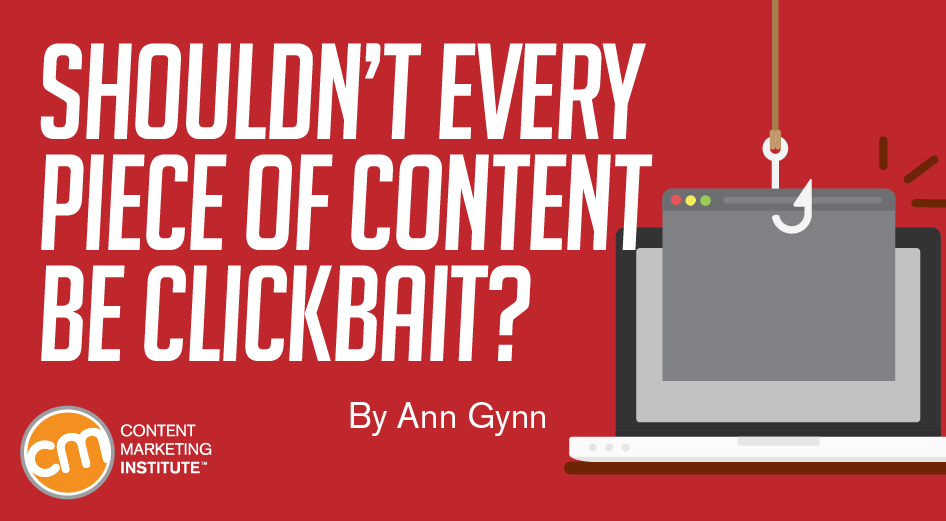So why does clickbait show up on lists, including Facebook’s, of content marketing mistakes or practices to avoid? David Ambrogio, SEO and content strategist at Online Optimism, offers a definition that touches on what the word clickbait connotes for many people – “any content with sensationalist headlines used to encourage clicks or drive ad revenue.” The problem with clickbait, says Gregory Golinski, head of digital marketing at YourParkingSpace.co.uk, is that it’s a one-sided deal with your audience. “Clickbait is tricking people into consuming your content by making them believe it will be better than what it really is. “Then you can deliver a clickbait title to address this behavior or need.” Are clicks the goal? “Someone can read it and get the information they need without having to click on the article or keep reading.” His advice works well for brands seeking to be expert resources or have their content be the featured snippet on the Google search results page. Angelo offers some BuzzFeed-like headlines for marketers to use for their own content: 25 ___ That Will Change the Way You ___ I Tried ___. Marketers want their headlines to stand out in the crowd to encourage searchers to click and connect with their content. Derek offers the example of a hypothetical article called Blogging Best Practices in 2013. No one post can provide all relevant tools in the space. Want to make your content marketing more powerful?

Welcome to the clickbait debate.
Credited to Jay Geiger, who first wrote about it in 2006, the term “clickbait” earned a place in The Oxford English Dictionary in 2016 with this definition:
“(on the Internet) content whose main purpose is to attract attention and encourage visitors to click on a link to a particular web page.”
Taken for its denotative meaning, clickbait does what all content marketers want – it entices the audience to click on the headline and consume their content.
So why does clickbait show up on lists, including Facebook’s, of content marketing mistakes or practices to avoid?
David Ambrogio, SEO and content strategist at Online Optimism, offers a definition that touches on what the word clickbait connotes for many people – “any content with sensationalist headlines used to encourage clicks or drive ad revenue.”
The problem with clickbait, says Gregory Golinski, head of digital marketing at YourParkingSpace.co.uk, is that it’s a one-sided deal with your audience. “Clickbait is tricking people into consuming your content by making them believe it will be better than what it really is. You take something from your audience without fulfilling your part of the deal: creating useful, quality content.”
But clickbait doesn’t have to live up (or down) to those negative connotations, others say.
Can clickbait be good?
“Clickbait isn’t necessarily bad,” says Andrew Selepak, a professor at the University of Florida. “While we often view clickbait negatively because it is associated with fake news and online hucksters, if your company has a solid product that can actually help consumers, getting people to your site by hook or crook isn’t such a bad thing.”
He offers P.T. Barnum’s “Greatest Show on Earth” label as an example of pre-internet clickbait: “While it is debatable that P.T. Barnum truly had the greatest show on earth, his clickbait advertising did get people to come see his show, and what they saw was entertaining.”
P.T. Barnum knew well that it was good business to make sure customers got what they expected. As he wrote in 1880’s The Art of Money Getting:
You may advertise a spurious article and induce many people to call and buy it once, but they will denounce you as an imposter and swindler, and your business will gradually die out and leave you poor.
Spurious articles to attract customers? That’s the clickbait content of the 19th century (and likely since the invention of the printing press).
Clickbait creates the curiosity gap
Patsy Nearkhou of Talkative UK offers two categories of clickbait titles – the spectacular and the mysterious.
A spectacular headline would be: Marketers Tried These 6 Insane Influencer Hacks … You Won’t Believe the Results! As Patsy explains, the headline is peppered with grandiose statements, directly addresses the reader, and contains several superlatives.
A mysterious headline might be: The One Word I Promised to Stop Using in 2018. It isn’t shouty but deliberately ambiguous.
“The continuous theme across all clickbait titles is that they appeal to the reader’s curiosity … they appeal to the same psychological process,” Patsy says. “They work because people are naturally curious creatures so it’s irrelevant whether they use grandiose or subtle tactics.”
Neil Patel believes clickbait gets a bad rap. “When done correctly, it’s one of the best ways to get people to take notice and give you their most precious asset: attention,” he writes.
Steve Kurniawan, content specialist and growth strategist at Nine Peaks Media, agrees. “Humans are curious in nature, especially for topics we already are interested in,” he says. “The key to a…

COMMENTS